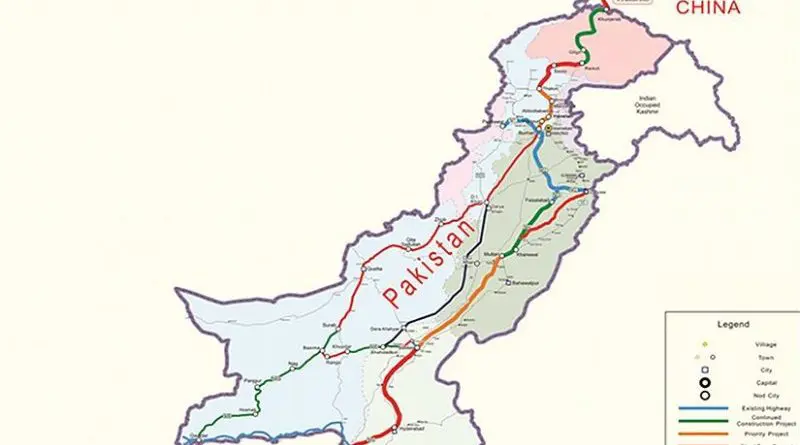CPEC, Regional Connectivity And Afghan Stability -OpEd
The China-Pakistan Economic Corridor (CPEC) is a centrepiece initiative of China’s Belt and Road Initiative (BRI). CPEC has evolved into an essential component of the BRI, connecting China’s western region to the rest of the world, including Central Asia. The BRI aspires to build a network of digital and physical infrastructure, such as roads, ports, trains, and telecommunications networks, that will connect 65 countries and provide a plethora of economic opportunities for those countries. The China-Pakistan Economic Corridor, its centrepiece, is critical to the larger BRI project.
CPEC provides new opportunities for regional integration, increased regional cross-border trade, and improved connectivity between China and Central Asian states. The corridor is critical to the region’s economic modernization, allowing for the establishment of new economic centres such as Pakistan’s Port of Gwadar, which is quickly becoming a significant hub for regional and international trade. CPEC has also played an important role in connecting Central Asian countries to the rest of the globe by increasing regional transit opportunities for Central Asian countries. The corridor has linked India and Bangladesh, two significant participants in Central Asia’s economic expansion, to Afghanistan, Pakistan, and Iran, all of which are key players in the regional economy. Furthermore, the corridor has linked Central Asian countries to the larger BRI, allowing them to engage in Chinese and international development programmes.
CPEC has increased industry activity, offering job possibilities for millions of people in Pakistan and the wider Central Asian region, in addition to the benefits of increased regional connectivity. The corridor also serves as a significant source of direct foreign investment in the region. Furthermore, as part of the CPEC, a number of special economic zones have been developed, enabling for the creation of foreign enterprises in the region and enhancing economic activity. CPEC has played a significant role in increasing Central Asian connectivity with the rest of the globe. Greater transportation opportunities, increased industry activity, and direct foreign investment have been important catalysts in the region’s economic development, opening up tremendous economic potential for individuals involved. The corridor has guaranteed that Central Asian governments are fully integrated into the global economic network, opening up new opportunities for all parties concerned.
Afghanistan is situated at the crossroads of East and West, as well as Central and South Asia. Many attempts have been made over the years to capitalise on Afghanistan’s strategic location and transform it into a regional commercial and transport hub. From north to south, diplomatic and economic resources have been poured into developing, negotiating, and implementing connectivity initiatives such as the United States’ New Silk Road initiative; the CASA-100 electricity project connecting Central Asia to Pakistan; the Turkmenistan-Afghanistan-Pakistan-India (TAPI) gas pipeline project; and a Trans-Afghanistan railway stretching from Uzbekistan to Pakistan’s seaports. China has long desired to formally include Afghanistan in its Belt and Road Initiative. These activities were complementary to a number of regional dialogue venues, ranging from the Regional Economic Cooperation Conference on Afghanistan and the Heart of Asia-Istanbul process to the Shanghai Cooperation Organization (SCO)-Afghanistan Contact Group.
Regional collaboration, on the other hand, has been fairly limited over the last two decades. This is primarily due to Afghanistan’s terrible security condition. Regional actors are nonetheless concerned about Afghanistan’s dismal security situation following the US pullout. Afghan security must be secure in order to reap the benefits of economic development and regional connectivity.
The Islamic Emirate of Afghanistan’s (IEA) Ministry of Industry and Commerce (MoIC) has welcomed Russia’s proposal to export gas to Afghanistan and Pakistan. Russian gas exports to Afghanistan and South Asia will benefit the region’s developing countries, who are in desperate need of electricity. Moscow is also negotiating increased gas supply to Kazakhstan and Uzbekistan. Such projects will also serve as a catalyst for contributing to Afghanistan’s economic well-being, which is under international sanctions.
Pakistan, which usually suffers from gas shortages during the winter season, will breathe a sigh of relief if this idea is implemented. In another case, the head of the Afghanistan Railway Authority, Mulla Bakhtur Rahman Sharaft, visited Pakistan and met with Pakistani officials to discuss the Trans Afghan Railway Line project. The bridge will connect landlocked Uzbekistan to Pakistani ports. The railway line is proposed to go from Mazar-e-Sharif to Torkham, connecting Central Asia to South Asia via Afghanistan. When finished, this route will create the closest, cheapest, and safest corridor connecting Pakistan to Central Asia.
Once completed, the project will go a long way toward bringing long-term economic success and cultural diversity to the region, transforming it into a crossroads of eastern and western civilizations.
Author is PhD Scholar (SPIR-QAU). Currently she is working in Islamabad Policy Research Institution (IPRI) as Policy Researcher/Consultant. Her work has been published in local and International publications.

